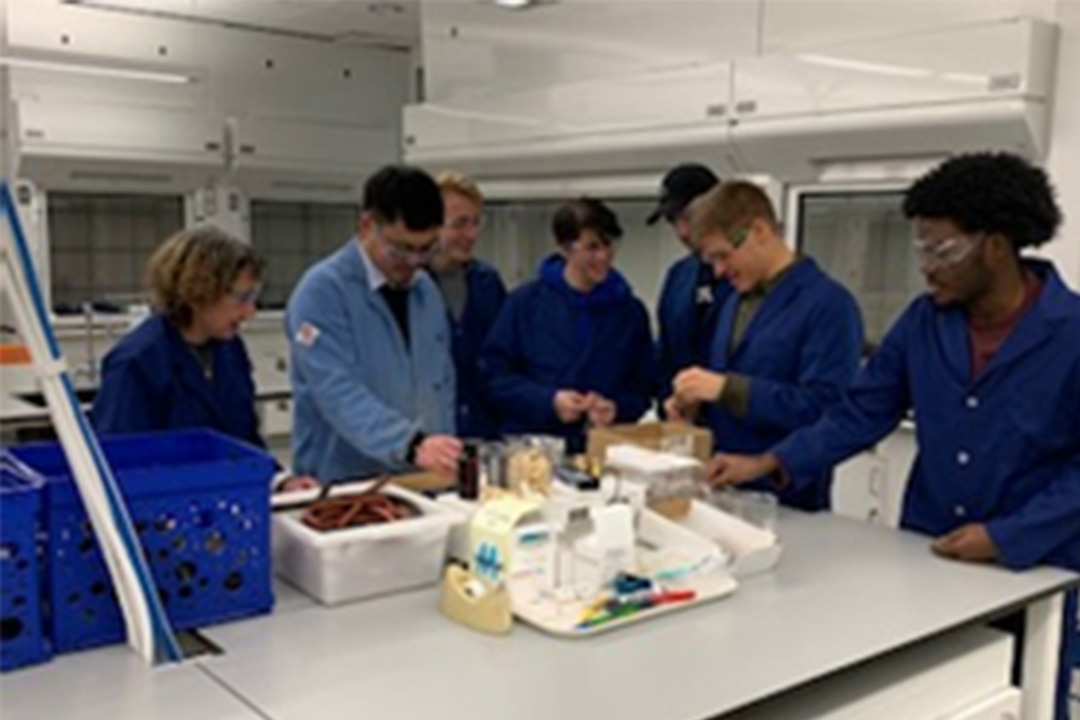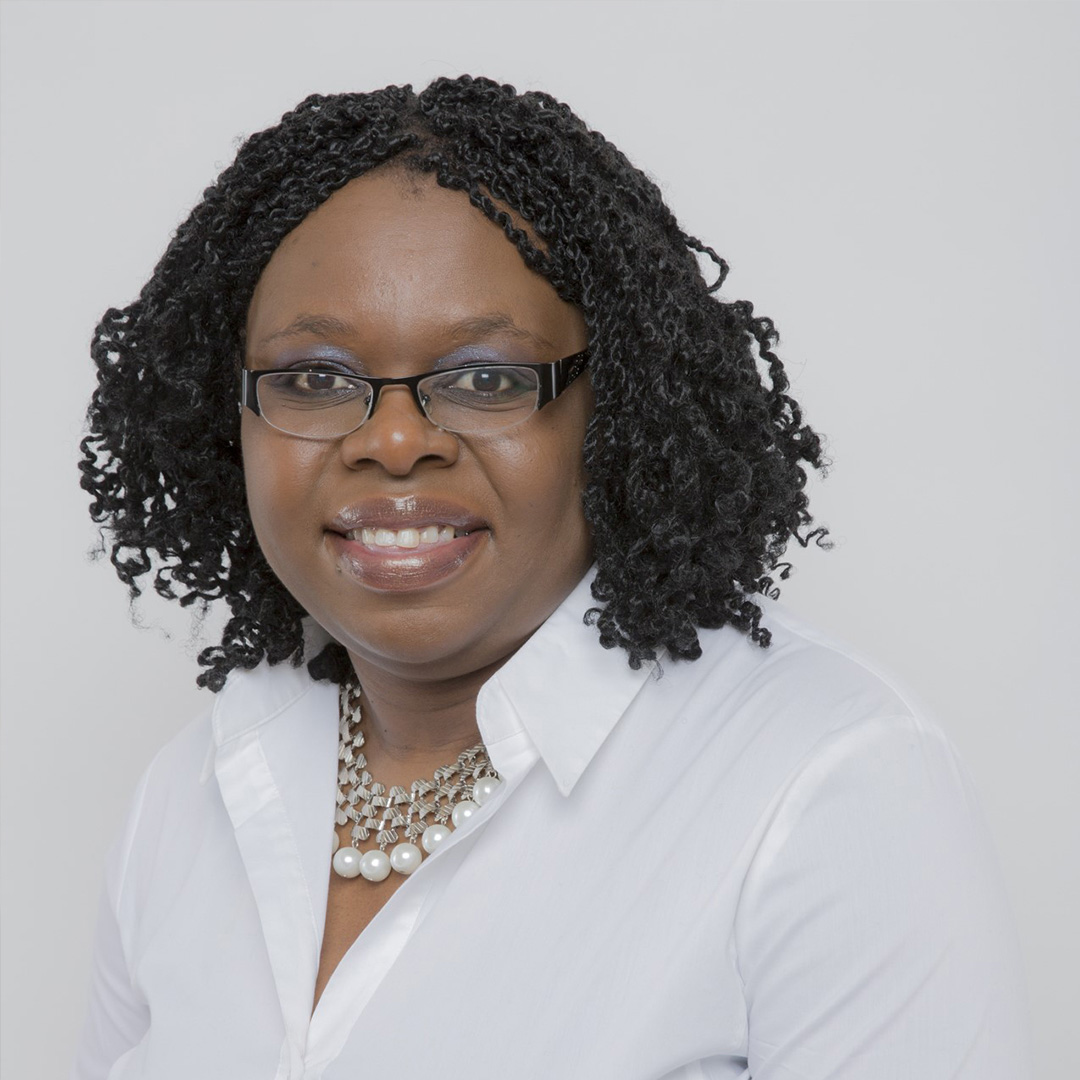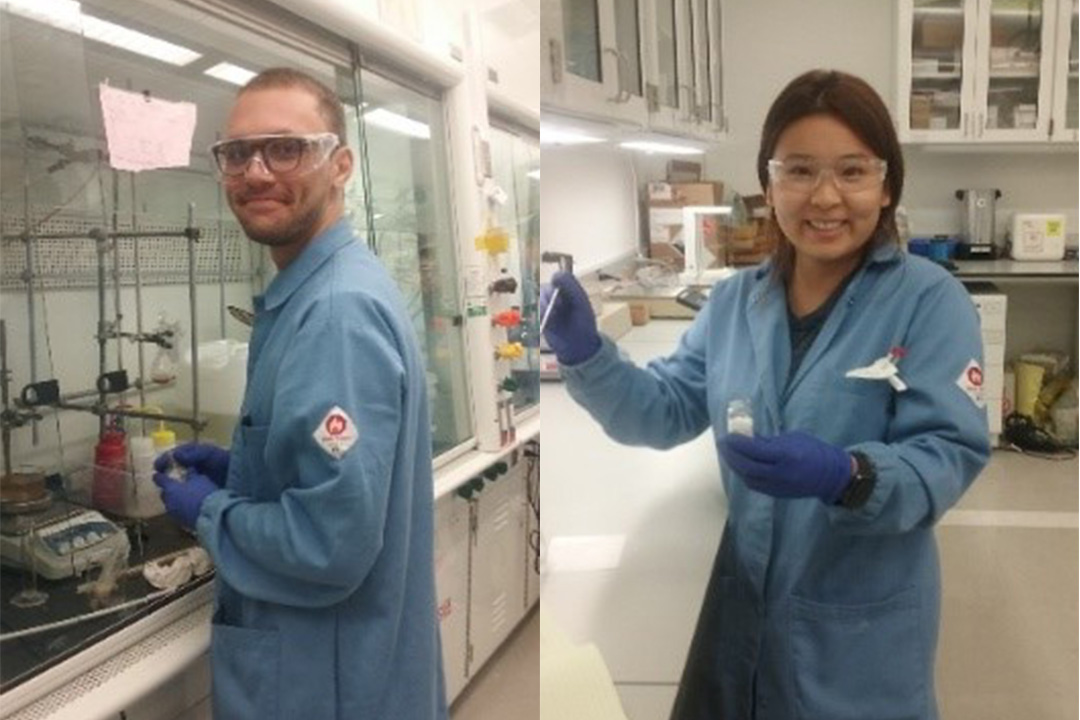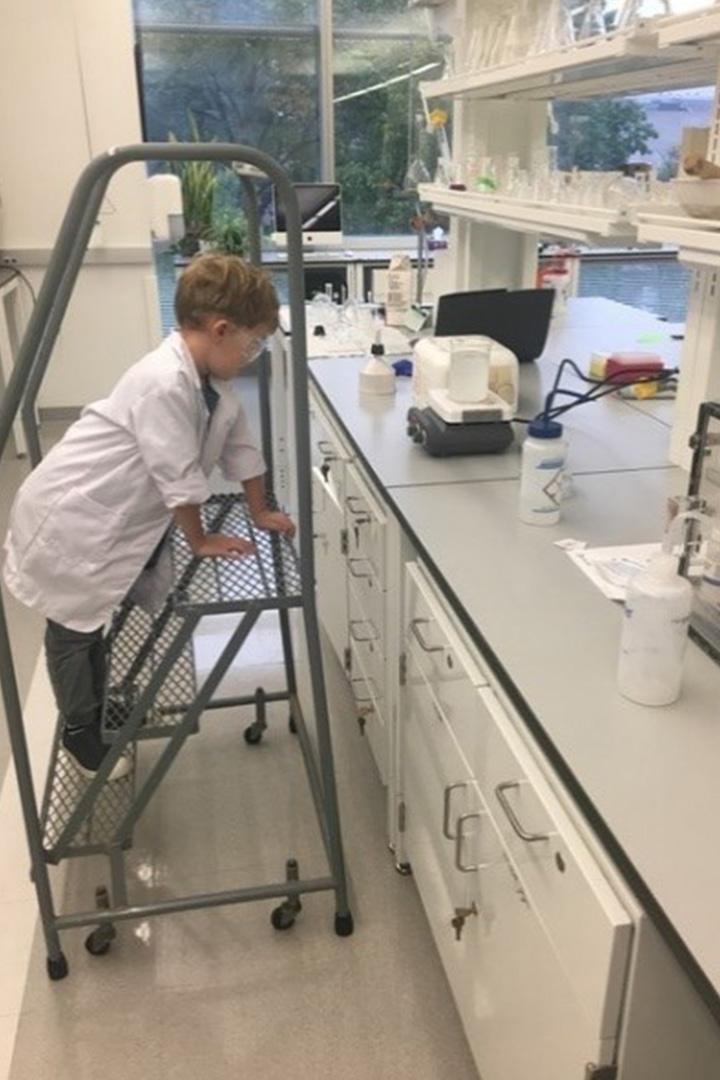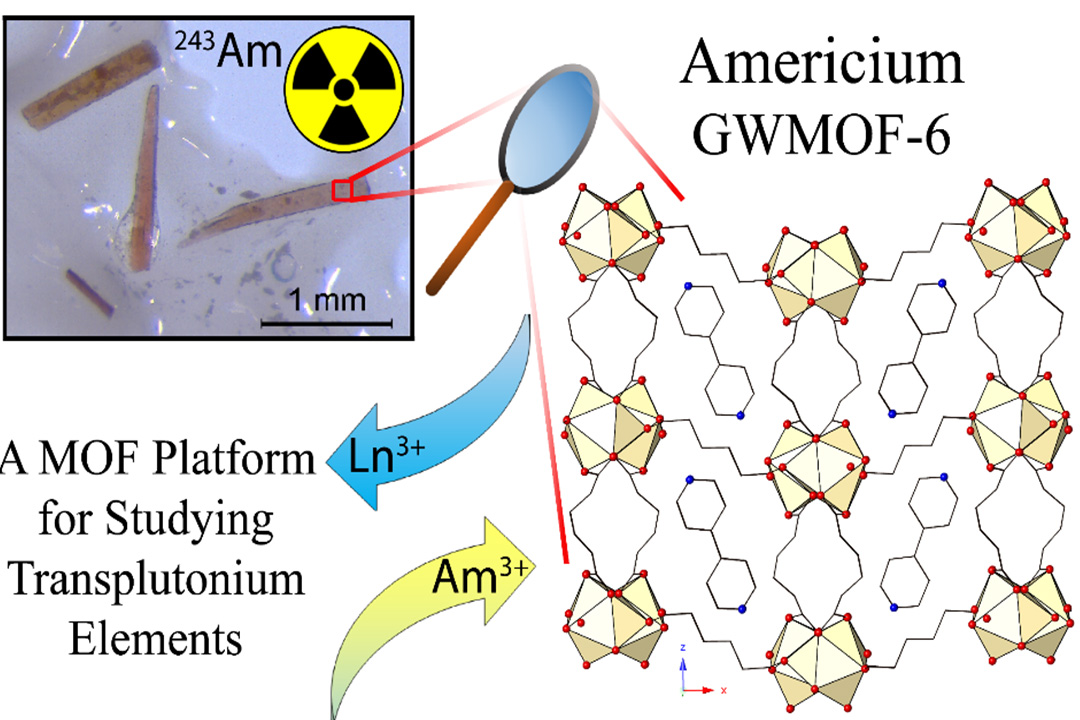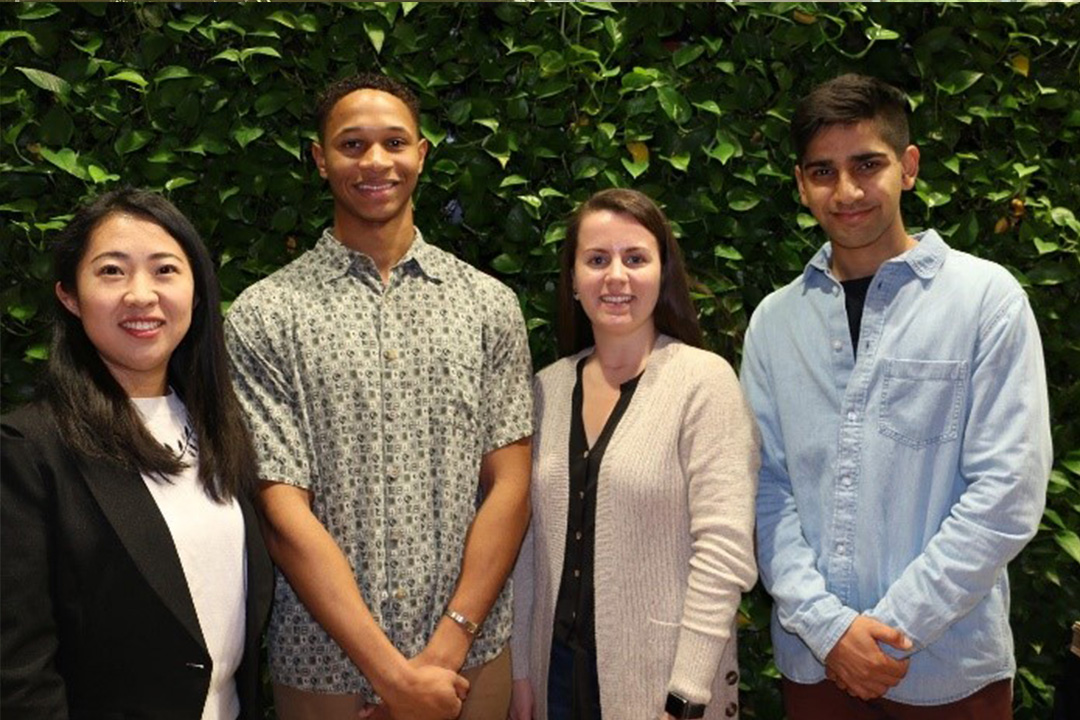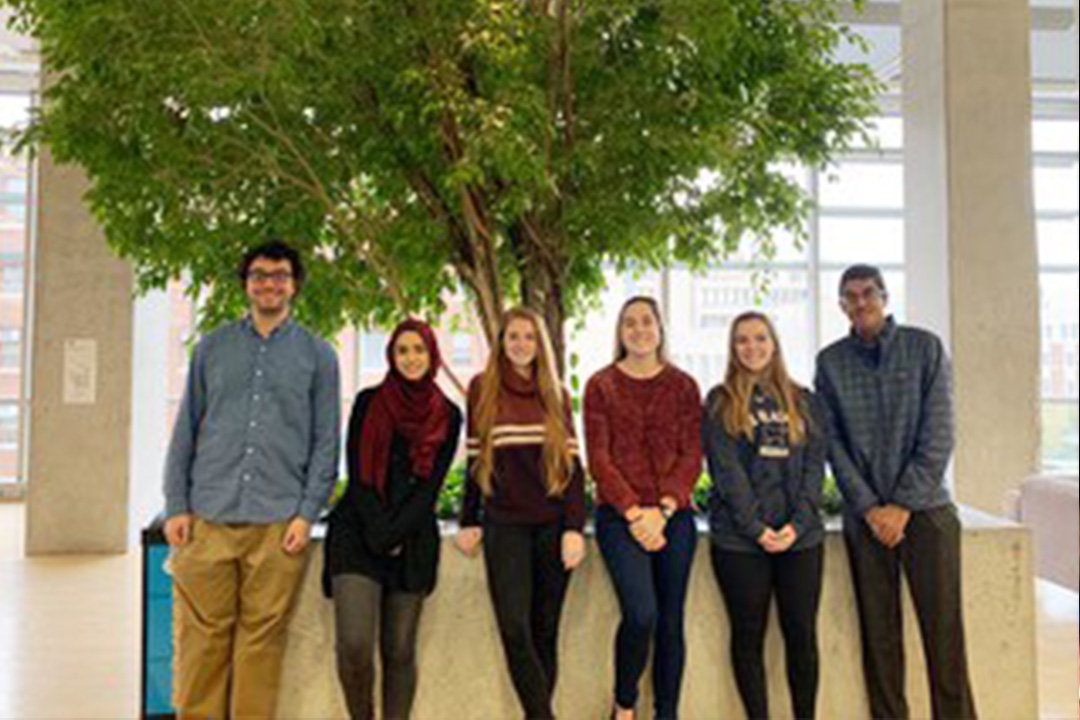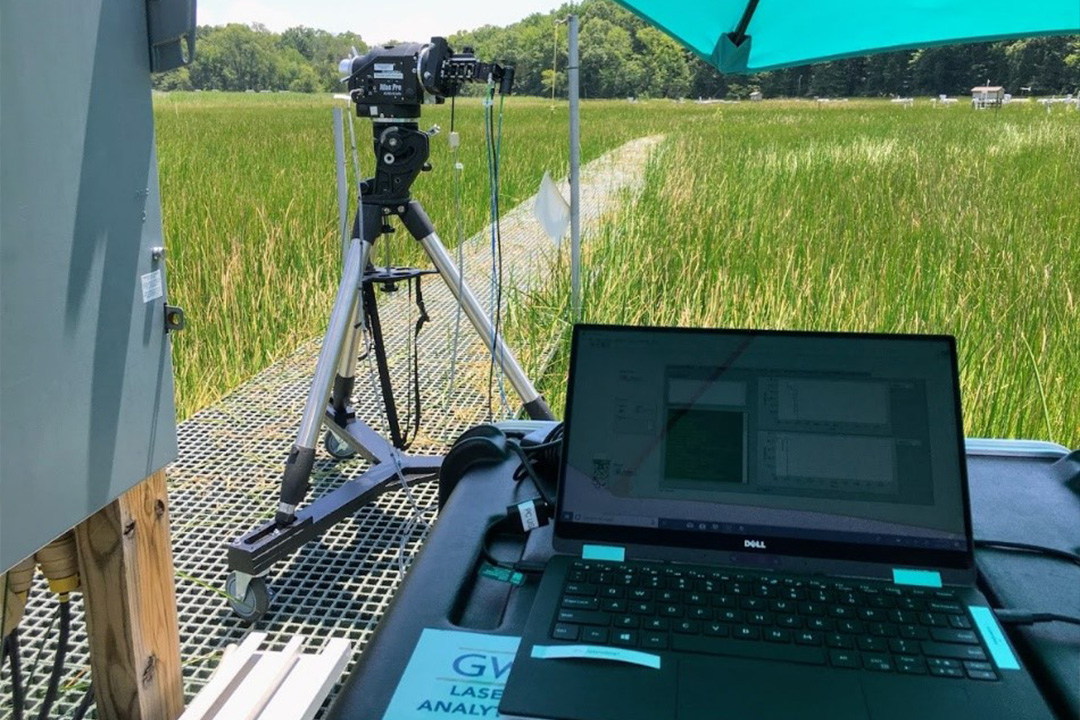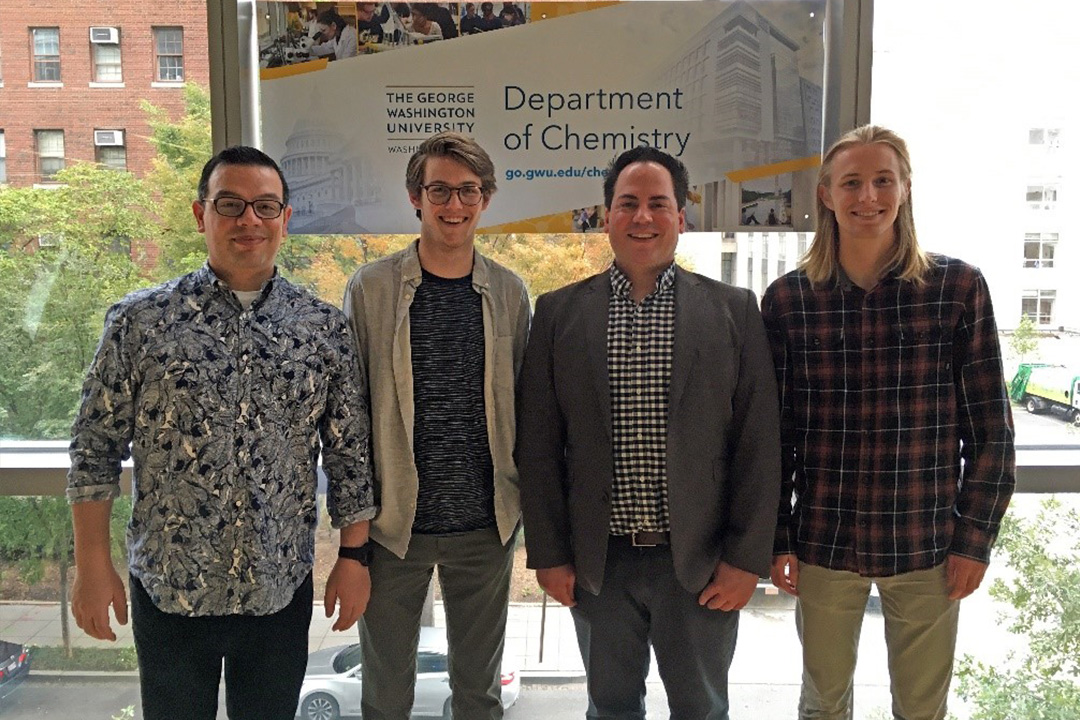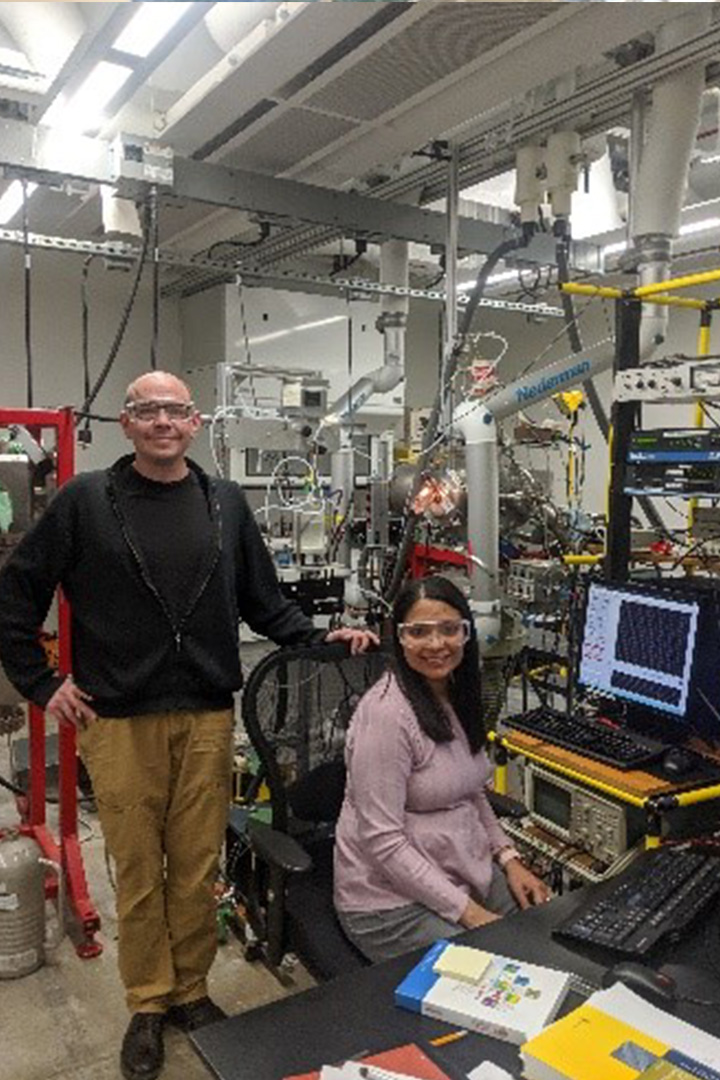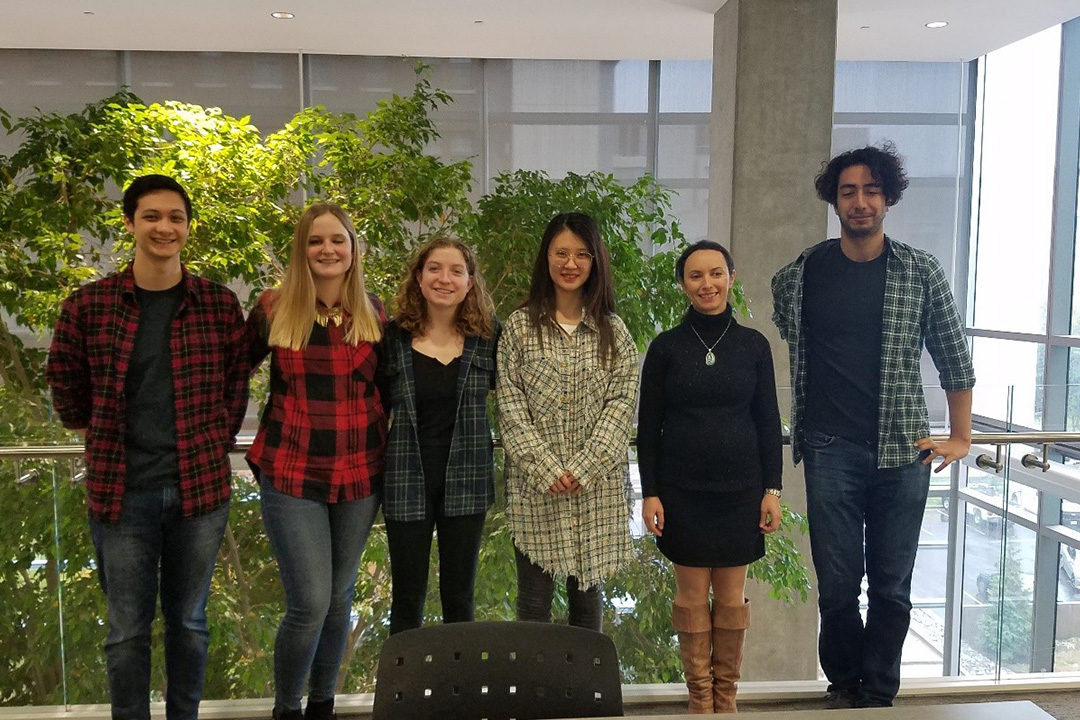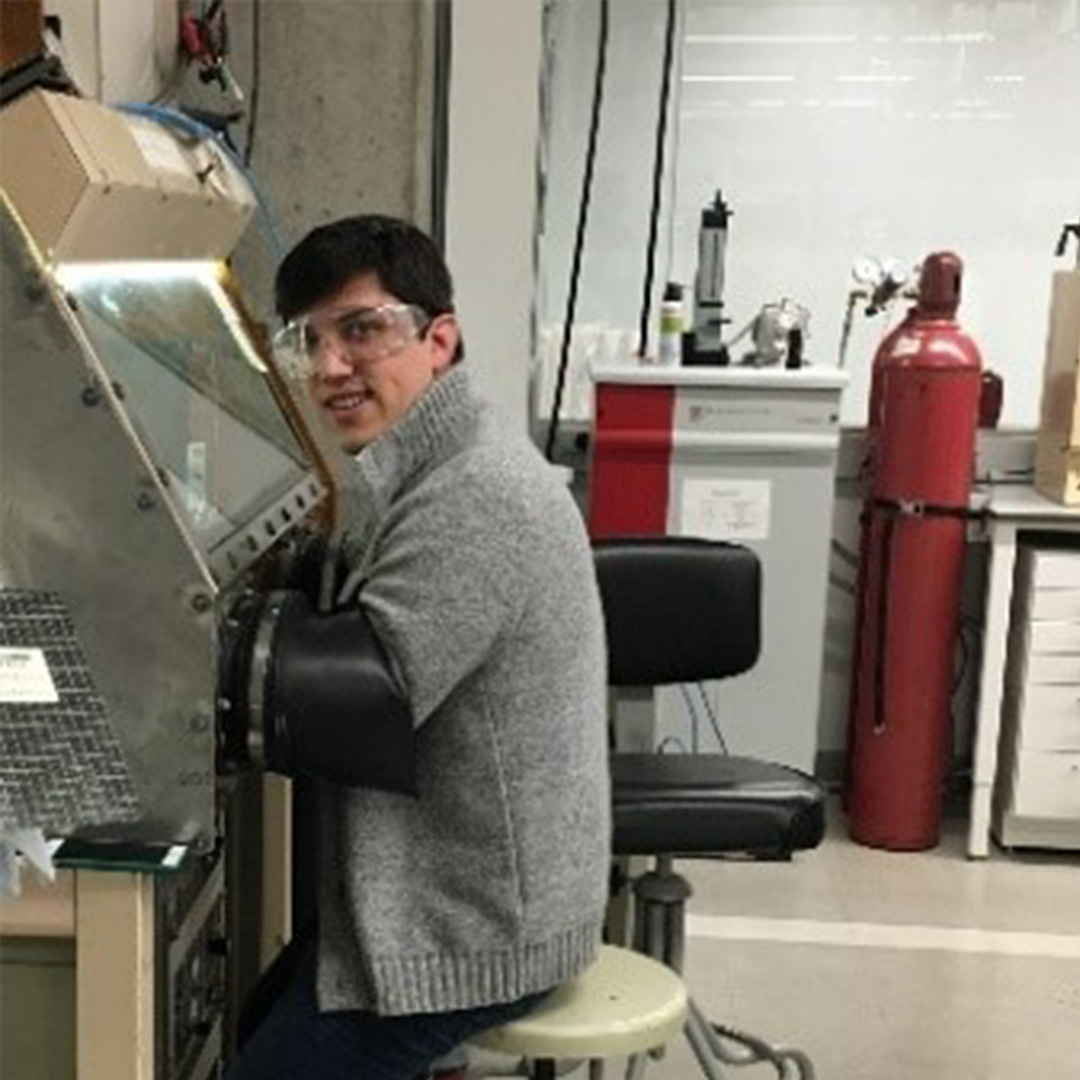Chemistry Newsletter, Spring 2020

Message from the Chair
Department Spotlight
Department Kudos
Faculty Kudos
Alumni Updates/Class Notes
Donor Recognition
Message from the Chair
Greetings to all of our alumni!
It’s been a whirlwind coming up to speed in the wake of Michael King’s 20+ years of tireless leadership. I took over the reins on July 1, 2019, and it turns out there is plenty to do in keeping the department on track and operating! Fortunately, we spent the last year or so developing a forward looking Five-Year Strategic Plan, and this has been serving as a roadmap for where we want to be and how we want to operate. Some significant progress has been made in terms of numbers of graduate students (now at 51—a record!) and new hires. The latter are featured elsewhere in this newsletter, notably Professors Clements, Razunguzwa and Schofield, where we have been able to deepen our roster by broadening faculty categories to address specific needs. Welcome aboard! While saying goodbye to long-time laboratory manager Greg Thomas we welcome Javeline Chansa, research program associate. Javeline has been part of the team for some time, yet her new duties will evolve to support the research enterprise more broadly. Looking ahead for the next few months, we have two faculty searches in progress. By the next newsletter, I hope to report on new bioorganic and physical chemistry assistant professors!
Dr. Christopher Cahill
Department Chair
Department Spotlight
From Student to Professor
Left to right, Dr. Clements surrounded by Chenyang Ma, Logan Bartholomew, Dominique Brager, Kenny Heidel, Rhys Dickhudt, and Christopher Hossack
Dr. Gail Clements was a chemical engineer employed at the DuPont Research Station in Wilmington, Del. While working in teams of engineers and chemists, she noticed that the chemists were having way more fun than the engineers. When she was able, Dr. Clements went back to school to see what exactly the chemists were enjoying so much.
Dr. Clements has been a member of the GW Department of Chemistry, in various capacities, since August 2008, when she entered the PhD program in Dr. Cindy Dowd’s lab. She graduated in January 2015 and became an adjunct professor teaching contemporary science for non-science majors. Since then, her teaching load steadily increased and now, as a teaching assistant professor, she teaches General Chemistry I, Organic I and II and Contemporary Science. Dr. Clements also is the Organic Chemistry Laboratory course supervisor. This is what happens if you stick around long enough! All of this allows Dr. Clements to share her passion for chemistry with undergraduates and the Organic Lab Graduate Assistants. She lives in Northern Virginia with her husband, Richard, and pug, Mayhem.
Mission: Improve Student’s Success in General Chemistry
Dr. Tabitha Razunguzwa
Dr. Tabitha Razunguzwa recently joined the faculty as a visiting assistant teaching professor of chemistry, and she is responsible for the development and implementation of a new course, Fundamentals of Chemistry. Originally from Zimbabwe, Professor Razunguzwa received her PhD from West Virginia University. She has over 10 years of teaching experience, mostly at the undergraduate level (General Chemistry I and II, Survey of Chemistry I and II and Introduction to Chemistry).
One of our big initiatives this year has been to improve students' success in General Chemistry. The Fundamentals of Chemistry course targets students whose performance in the Chemistry Preparatory Course indicates a need for introductory work prior to enrolling in a general chemistry course. The course aims to improve students’ math skills (especially algebra) and study skills; assist students with no previous chemistry experience; and bridge the gap between high school and the standard first-year chemistry sequence, General Chemistry I and II. Professor Razunguzwa is also responsible for holding weekly recitation sessions for students who are currently enrolled in General Chemistry I.
Welcome New Faculty Member Dr. Mark Schofield!
Dr. Mark Schofield
Dr. Mark Schofield recently joined the faculty as a research professor of chemistry where he is pursuing research on the electronic structure of actinide materials assembled with non-covalent interactions. Originally from New England, Professor Schofield received his PhD from the Massachusetts Institute of Technology and performed post-doctoral research at the University of Chicago.
Following a 20+ year teaching career at the University of Chicago, Williams College and Haverford College among others, he has taught chemistry here at the graduate (Advanced Inorganic Chemistry) and undergraduate (Instrumental Analysis, Inorganic Chemistry, Quantitative Analysis, General Chemistry II) levels. He notes the diverse interests of the students he has encountered, the facilities (including two supercomputer clusters), eclectic research at GW and the accessibility to science policy in a national context through the Elliott School as just a few of the “perks” of teaching at GW. In his diminishing spare time, Professor Schofield likes to take the chemistry show “on the road,” including a recent stop at Lafayette Elementary where his twin daughters are in kindergarten.
Department Kudos
Our faculty and students continue to push the boundaries of science in their cutting-edge research. Read on to learn about the amazing accomplishments in their chemistry labs.
Graduate and Visiting Students Finding Success in the Besson Lab!
(L-R) Loïc Fontaine and Christine Park, visiting students
This spring, the Besson research lab saw the oral presentations of graduate students Maegan Dailey and Chenyang Ma at the ACS National Meeting in Orlando and the Mid-Atlantic Regional Meeting in Baltimore. Maegan doubled down with a successful candidacy defense in June, while making good progress on her NSF-funded work on goblet-shaped magnetic complexes with single molecule spintronics applications. While undergraduate student Elliot Heywood abandoned us this summer for an internship in fine cooking (he has since come back, continuing this fall his work on zinc trispyrazolyl complexes), Chenyang, Maegan and undergraduate student Haley Meyers were joined by three visitors. Matthieu Maciejewski, one of our high school alumni, now an undergraduate at Haverford College, found the lab grown since his initial stay three years ago. Our second visitor was Loïc Fontaine, a master’s student from the École Centrale Marseille in France, who stayed in the group for six months working on iodinated bisphthalocyanine complexes. Given the success of his stay, we hope to welcome many more students for similar internships in the future! Our third guest was Christine Park, a high school student who came to us via our partnership with STEMship. After two months of slow solvent evaporation, Christine's target complex finally crystallized last week. Stay tuned for the corresponding publication
Dr. Boyes Research Lab is Up and Running with the Help of Grad Students
Graduate student Rhys Dickhudt
The Boyes research lab is finally becoming functional after the long move from Colorado! This is primarily due to the hard work of Caleb Reese who moved to GW from Colorado to continue his work on the NSF-funded project examining the use of aromatic polyamide brushes for water purification. In conjunction to utilizing his moving and handyman skills, Caleb is also working on a review paper and his first research manuscript. With the lab functioning, first-year graduate students, who have been patiently waiting, can finally start rotations in the Boyes group by learning the joys of synthesizing polymer, as modelled outstandingly by Rhys Dickhudt in this picture! The group is looking forward to its first group of undergraduate students joining the lab in the spring semester’s research into the development of functionalized, biodegradable polymer scaffolds for tissue engineering and polymer-modified nanoparticles as stimuli-responsive MRI contrast agents will hopefully start again soon, after the recruitment of some eager new graduate students.
There is Always a lot Happening in the Cahill Group!
New post-doc Aaron Nicholas (via UMaine) is off to an amazing start with some 20+ new indium halide compounds, many of which were produced by our summer high-school researcher, Ryan Halli from Montgomery Blair in Silver Spring, Md. A newly installed X-ray diffractometer (Thanks, GW!) makes structure determination a cinch, and folks are in a period of unprecedented productivity. We are keeping in touch with former group members, particularly Dr. Gian Surbella who is now staff at Pacific Northwest National Lab. Gian is actually hosting current PhD candidate Nicole Byrne as we speak, and they are producing some amazing transuranic compounds. Soon to defend grad student August Ridenour just published the FIRST americium containing metal organic framework material. This was a yeoman’s effort across GW, UNLV and PNNL--well done everyone. Chris is settling into life as chair, although there does not seem to be a “new normal” with all of the great things happening in the department and the university. Nevertheless, Chris spends his Saturday mornings in the lab with 6-year-old Wesley in preparation for the 2019 US Crystal Growing Competition. Stand back for the best alum crystal the world has ever seen!
Many Frontiers for the Dowd Research Lab
(L-R back row) Samuel Kirby, Dee Bague, Kenny Heidel, George Logan Bartholomew, Hailey Butman, Dr. Dowd (L-R Front row) Devi Alaparthi, Matthew Lish
The year 2019 saw lots of opportunities for the Dowd lab to present our work, recruit new students and bid farewell to our postdoc and longtime undergraduate researchers. In May, several students presented work at the Frontiers at the Chemistry-Biology Interface Symposium, held at NIH. Dr. Cindy Dowd was fortunate to be invited to both the Tuberculosis Gordon Research Seminar and Conference in Barcelona, held in July. She continues discussing our results at invited talks this fall at UMass Amherst and the Drug Discovery 2019 meeting in Boston. Synthesis of novel antimicrobial compounds continues full speed in the lab by three doctoral students and two undergraduates. We bid farewell this year to longtime undergrads Matt Lish, Kusuma (Devi) Alaparthi and Richie Beck, as well as postdoctoral researcher Dr. Rene Chofor. We wish them all the best! Cindy continues to serve on the CCAS Dean’s Council and as chair of graduate admissions for chemistry. In addition, she was recently recruited to serve on one of GW’s strategic planning committees—important work as GW moves forward! We are looking forward to the year ahead as an opportunity to publish our work and increase the visibility of our science.
A Great Start for the New Hao Research Lab
(L-R) Dr. Hao, Nicholas Randolph, Ashley Frankenfield, Mustafa Amed
The Hao lab is off to a great start! We welcomed our first graduate student, first-year chemistry PhD student Ashley Frankenfield, and undergraduate students Nicholas Randolph (senior in chemistry), and Mustafa Ahmed (sophomore in public health). We thank them for joining the lab!
The Hao lab focuses on developing mass spectrometry-based bioanalytical methods to study proteins, peptides, and small molecule metabolites involved in human disease processes. Specifically, 1) we develop novel proteomics and metabolomics strategies in complex biological samples; 2) we implement multidisciplinary approaches in the human induced pluripotent stem cell (iPSC)-derived neurons, mouse models, and clinical human subjects to study the molecular mechanisms of neurodegenerative diseases.
If you are interested in joining our lab as graduate/undergraduate/visiting students or postdoctoral fellows, feel free to contact Dr. Ling Hao.
Dr. King Stepping Down as Columbian College Marshal
Dr. King serving as marshal at the 2019 Commencement
Dr. Michael King writes: “When I stepped down as chair at the end of the last academic year, I also tendered my resignation as Columbian College marshal. Dean Robert Kenny was kind enough to appoint me as the CCAS college marshal in 1990, succeeding Professor Robert Jones, who had decided to retire that year. I served in that capacity again in 1991, at which time the separate school commencement programs were disbanded in favor of a University-wide commencement. In 1996, Interim Dean Edward Caress invited me to reprise the role of college marshal, when the school-wide ‘Celebrations’ were instituted following a controversial ‘rain out’ of commencement the year before. It was my privilege and an incredible honor to serve as college marshal continuously thereafter and to also serve as a faculty marshal at many Commencements, Doctoral Hoodings and other university events. Academic year 2018-19 marked 25 years of service as the Columbian College marshal and an appropriate milestone to close that chapter of my career at GW. We began in 1990 with a single program for all CCAS bachelor’s, master’s and doctoral degree candidates in a single program, along with the awarding of an honorary degree. Last spring, we held for separate programs over three days, a challenging logistical undertaking reflecting the growth of the college. To be a part of the graduation festivities for so many GW students has been truly awesome, and so I was particularly humbled and honored to have the title College Marshal Emeritus conferred this fall by our current Dean Paul Wahlbeck. This has been a wonderful memory as I head into my coming retirement, and I thank all of you who have been a part of those Celebration festivities. I hope you too have as fond a memory of your graduation weekend.”
Kostal Research Lab’s Expanding (Green) Footprint
Graduate student Preston Griffin
It’s been a productive year for the Kostal group! We continue our research developing new computational approaches to designing safer chemicals, focusing mainly on pesticides and flame retardants. We are also engaged in a collaborative project funded by NSF to design new ionic liquids for biomass valorization. Preston Griffin, a second-year graduate student, leads our computational efforts on this project along with Sam Vaccaro, a senior chemistry major. Preston participated in the 2019 ACS Summer School on Green Chemistry and Sustainable Energy, exploring scientific solutions to global sustainability challenges with likeminded graduate students and postdoctoral researchers. Both Preston and Sam are set to travel to the 2020 YES SETAC meeting in Waco, Texas, where they will present our ionic-liquids work to budding environmental toxicologists, helping strengthen this vital collaborative bridge between chemistry and toxicology. Selene Ramer, a senior undergraduate student, who has been extending our predictive tools for ecotoxicity to pesticides, gave a talk on her work at the 2019 ISGC International Symposium on Green Chemistry, funded by the prestigious ACS Joseph Breen Memorial Fellowship. Amanda Chen, a senior undergraduate student, is working in collaboration with Matias Ramos (Milken School of Public Health) and the Voutchkova-Kostal group to synthesize and test in vitro some of our newly developed analogs of commercial flame retardants for their endocrine activity and neurotoxicity. We said goodbye to Matt Winfough, a graduate student, who moved to UC Riverside, and we welcomed a new undergraduate into our group, Preksha Patel, who is presently learning the ropes, working with Sam Vaccaro on trying to understand the energetics of cellulose hydrolysis by imidazolium-based ionic liquids. In collaboration with scientists at Versik 3E and the United States EPA, Dr. Kostal will be organizing two conference sessions in 2020 revolving around research efforts in the group, one at SETAC Dublin and one at ACS GC&E. Also, look for us at the 2020 Gordon Research Conference in Green Chemistry!
Focusing on Proteins in the Massiah Research Lab
(L-R) Paul Randazzo, Iman Syed, Jessica Webb, Allie Mennella, Erin Gladu and Suraj Kandoth
The Massiah group recently has been focusing on understanding how two proteins with a very similar structure have the same function but different levels of activity. To answer this question, the group uses several physical techniques: the use of NMR spectroscopy to examine how specifically two proteins interact; Isothermal Calorimetry and fluorescence spectroscopy to measure the binding strength of two proteins; and several biochemical experiments to measure rates of reaction. These experiments are intended to provide evidence that differences in these binding interactions can explain the differences activity. The idea is far reaching, because this family of enzymes plays a critical role in normal cellular function. A loss of function can result in human health related problems. This information can be used to regulate the activity of this family of enzymes as they might be related to specific health problems. Jessica Webb is in her second year as a PhD student and is diligently working on this project. She is joined by new volunteer Paul Randazzo. We currently host 4 undergraduates all working on independent projects. Their results are integral to the overall success of several projects in the lab, including the enzyme engineering project. The included photo shows these bright graduate and undergraduate students from the lab. The book chapter, titled: “Zinc-binding B-box domains with RING folds serve critical roles in the protein ubiquitination pathways in plants and animals,” was published and is well received by the scientific community with more than 100 downloads.
Advancement on Combustion and Atmospheric Project by the Miller Lab
Miller Lab field work
The Miller research lab continues to have great progress to report from both our “combustion” and “atmospheric” projects. Jen Giaccai has been busy traveling to Asia to collect ink samples to be used in her Smithsonian Institute-funded project to explore the use of Raman spectroscopy to analyze (soot based) black inks. Katie Hinnant has installed her exhaust gas sampling rig, developed at GW, at the Naval Research Laboratory (currently for CO2 but expandable to CO) in her project to test replacement fire-fighting foams. Andrew Kamischke is exercising our new Optical Parametric Oscillator system to look at laser-induced fluorescence of polynuclear aromatic hydrocarbons in flames. Monica Flores has been using our “PHOCS” instrument to measure oxygen, water vapor and carbon dioxide in downtown Washington and at the Smithsonian Environmental Research Center as part of our DOE grant with Mesa Photonics. Finally, Shellie (Jacobson) Golden’s paper on the “Chemical Composition of Soot” has been submitted for publication. This paper reports exciting laser desorption/ionization mass spectrometric results from a collaboration with the Vertes group.
Rodriguez Lab Collaborations Here and Around the World
(L-R) Felipe Montecinos, Post-Doctoral Scientist; Justin Hachey, undergraduate researcher, Erik A. Rodriguez, Assistant Professor; and Jack Conlon, undergraduate researcher.
The Rodriguez Lab is fully functional and performing research with collaborators around the world. Felipe Montecinos joined the group as a post-doctoral scientist. Three grants were awarded this year, including the University Facilitating Fund (UFF), Cross-Disciplinary Research Fund and GW Cancer Center/Katzen Pilot Award. The UFF supports new correlative light and electron microscopy tools. The Cross-Disciplinary Research Fund was awarded with Vesna Zderic (SEAS, Department of Biomedical Engineering) and Mary Ann Stepp (SMHS, Departments of Anatomy & Regenerative Biology & Ophthalmology) for ultrasound-enhanced delivery of macromolecules for treatment of ocular diseases. The GW Cancer Center/Katzen Pilot Award develops new tools for imaging cancer with fluorescent protein nanoparticles and fluorescent personalized drug screens. Erik presented at the International Meeting on Optical Biosensors (Ghent, Belgium), 2019 BRAIN Initiative Meeting (DC), 14th International Conference on Tetrapyrrole Photoreceptors in Photosynthetic Organisms (Sidney, AU), and University of Tasmania (Hobart, TAS). Three papers have been published since May 2019, one paper is under second review at Nature Communications, and four papers are in preparation for submission, which include two undergraduate researchers, Justin Hachey and Jack Conlon, and two Nobel Laureates in Chemistry, Roger Tsien (2008) and W.E. Moerner (2014), as authors.
Sadtchenko Research Lab on Understanding Melting Permafrost and its Effect on Climate Change
(L-R) Dr. Sadtchenko and graduate student Rinipal Kaur
Inspired by potential challenges and dangers associated with climate change phenomena, the Sadtchenko group initiated a program of experimental studies with the focus on molecular dynamics, phase transitions, and chemical reaction at grain boundaries in polycrystalline ice. In these experiments micrometer thick films of very fine-grained ice are grown in a vacuum by physical vapor deposition technique. The physical and chemical processes in such films are then interrogated by a combination of fast scanning calorimetry and fast thermal desorption spectroscopy techniques, which have been developed by Sadtchenko’s team over the past several years. The ultimate goal of these studies is to close gaps in understanding the chemistry of melting permafrost and its contribution to climate change.
Voutchkova Research Lab Submits New Patent Application
(L-R) Chris Reid, Rebekah Brucato, Kiera Culley, Kai Wang, Dr. Voutchkova and Ege Ipek
In the past year, the Voutchkova group has focused on two current NSF projects: one, aiming to transform two waste products (CO2 and glycerol) into valuable chemicals using supported catalysts, and the second, aiming to develop environmentally-benign ways to turn inedible plant material (like wood) into valuable chemicals. We just submitted a full patent application on the technology for the first project with the support of the GW Technology Commercialization Office and are working with a company to show the viability of the process. On the publication front, we made the cover of Wiley journal ChemSusChem with an article on decarboxylation of biomass-derived aldehydes, and Professor Voutchkova was guest editor of a special issue of ACS Sustainable Chemistry and Engineering on “Hydrogenation Transfer Strategies for Biomass Valorization.”
Wagner Research Lab Making Headlines
Doctoral candidate Dustin Abele
The Wagner lab welcomed two new members, Jessica Schott, who is working on multimodal MRI contrast/cancer therapeutic nanoparticles, and Michael Womble, who is conducting his research on carbon nanochains. Kevin McKenzie and Dustin Abele are continuing their PhD studies, and Nathan Banek won a very prestigious IC postdoctoral fellowship. The highlight of our research was the publication of “Sustainable Conversion of Lignocellulose to High-Purity, Highly Crystalline Flake Potato Graphite,” which was named an “editor’s choice” (making download free), a cover article and was highlighted with a story in C&E News (Making Sustainable Battery Electrodes from Sawdust).
Dr. Zysmillich‒Innovating Student Engagement
Dr. Zysmilich and his recently adopted recue puppy Lola
Professor Zysmilich is the new deputy chair of the Chemistry Department, assisting the new chair, Professor Cahill, with the daily academic and administrative affairs of the department. A big initiative for this year has been to tackle some issues with student success in General Chemistry. Professor Zysmilich attended an ALEKS (Assessment and Learning in Knowledge Spaces) workshop in Chicago and worked closely with the GW administration and school advisors to develop a web-based summer Chemistry Preparatory Course using this platform. We are looking forward to new and innovative ways to engage today’s students.
Professor Zysmilich also serves as the director of graduate studies for the Chemistry Department. As such, he has been strengthening graduate recruiting efforts, designing new recruiting materials and participating in the Graduate School and Recruiting Fair at the Southeastern Regional Meeting of the American Chemical Society in Savannah, Ga.
Faculty Kudos
Congratulations to Professor Jakub Kostal who is a recipient of the prestigious NSF CAREER Award for a computational study of the environmental fate of pesticides. The NSF CAREER Award recognizes faculty members who exemplify the role of teacher-scholar through research, education and the integration thereof within the context of the mission of their organization.
Professor Stuart Licht remains a finalist in the Carbon XPrize competition after being selected last year. This international competition offers a $20 million prize for innovative solutions to CO2 utilization. Efforts therein were also recognized as a “Top 10 Innovation in 2018” from the Innovations for Cool Earth Forum.
Professor Michael Wagner has been very successful in attracting new funding. His recent awards include:
- Conversion of Coal to Li-ion Battery Grade “Potato” Graphite, U.S. Department of Energy; $950,000 over three years starting September 2019. This effort will develop an inexpensive, environmentally friendly route to graphite to bridge the oncoming supply/demand gap for EV batteries.
- Hollow Carbon Nano-sphere Research and Development, National Reconnaissance Office; $355,000 over two years starting October 2019. He and his team will develop advanced materials for next generation batteries for long range, rapid recharge EV’s.
- Advanced Energy Storage and Generation for Satellites, ORISE; $324,000 over three years starting October 2017. And if Earth-based efforts aren’t enough, he and his team are looking at next generation batteries for satellites.
Professor Akos Vertes is currently on sabbatical, which includes lecture tours and extended residences at universities across Hungary and China.
Class Notes
Nathaniel Bachtel, BS ’17, is in his second year in Yale's Medical Scientist Training Program, about to start his clinical rotations and committed to doing his PhD work in immunobiology.
George Chang, BS ’82, MS ’86, is a physician practicing in general adult urology at MedStar Washington Hospital Center in Washington, D.C.
Arthur DeLuigi, BS, BA ’97, is the department chair of physical medicine & rehabilitation at Mayo Clinic Arizona. He also serves as the medical director for sports medicine, leading the growth of clinical services, education and research.
Peter Dreifuss, PhD ’84, and his wife are retired with homes in Massachusetts and Maryland. They have two grown daughters and three grandsons.
Lawrence Fertel, BS ’81, is the research director at IsleChem LLC in Grand Island, N.Y., and still enjoys going into the lab and discovering new reactions. IsleChem specializes in process research and development and scale-up of specialty chemicals for a variety of clients.
Ricardo Gonzalez, BS ’75, got his an MD degree after his time at GW and spent 32 years as a child and adolescent psychiatrist in California. He retired in 2018 at age 70 and now lives in Albuquerque with his 90-years-young mother.
Madeleine Jacobs, BS ’68, was elected to the board of Collegiate Directions, Inc., a nonprofit providing motivated low-income students in Maryland free college and financial aid test counseling, test preparation and mentoring through college graduation.
John Kopriva, BS ’15, recently completed a four-week rotation in orthopedic surgery at Stanford University Medical School. As a GW basketball player, he was named the 10th Academic All-American in program history.
Andrew Kerr, PhD ‘15, works at the Naval Surface Warfare Center Indian Head EODTD installation. His work consists of the synthesis and characterization of novel energetic materials.
Bryan Laliberte, BS ’02, MS ’03, began a new position as the chief of anesthesiology at Landstuhl Regional Medical Center in Germany and was promoted to lieutenant colonel in the U.S. Army. His wife and four children are adapting well to living overseas and enjoying frequent travel.
John-Hanson Machado, BS ’16, crossed the United States on foot for the Ulman 4K for Cancer Team Boston. The event was sponsored by the Ulman Foundation, a Baltimore-based nonprofit supporting young adults impacted by cancer.
Peter Tarassoff, PhD ’74, MD ’78, is enjoying spending time with his family and traveling with his wife, Carol.
Craig Westphal, MA ’03, PhD ’04, recently accepted a new position at Axalta as the global technology manager for analytical and weathering sciences. He is currently based at the Global Innovation Center for Axalta Research and Development in Philadelphia, Pa.
Yazeed Yabroudi, BS ’09, has been the senior superintendent of the Raw Material Laboratory at Emirates Global Aluminium since 2009. He led his team to ISO/IEC 17025 accreditation in October 2019.
Donor Recognition
The Chemistry Department would like to gratefully acknowledge the following generous donors who made a gift to the program from January 1, 2019 – December 31, 2019.
+ Faculty/Staff | # Parent | ~ Student | * Friend
George Bartholomew ~
Brittany Bernstein, BS ’18
Elizabeth Donaldson, AA ’59, BS ’61
Lawrence Fertel, BS ’81
Carly Filgueira, PhD, BS ’03
Sebastian Filgueira, BA ’02, MA ’03
Dwayne Gamble +
Susan Gillmore, PhD +
David Goldberg, AA ’52, BS ’54
Susan Gordon #
Thomas Hall, BS ’73, M.D. ’77
Susan Heald, BA’ 85
Jennifer Herdman, PhD ’12
Raj Narayanan Iyer, PhD ’92
Madeleine Jacobs, BA ’68
George Latimer, PhD, AA ’53, BS ’55
Victoria Perros Levi *
Michael M *
Le-Nhung McLeland, MS ’76
Haley Meyers +
Alan Nadel, BS ’71, J.D. ’76
Robert Pellenbarg, PhD, BS ’71
Richard Reeves, PhD, AA ’48, BS ’50
Louis Rosenfield, BA ’74, M.D. ’77
Mitchell Ross, M.D., BS ’77
William Setser, MS ’62
Ann Shulman, BA ’66
Joel Shulman, Ph.D., BS ’65
Richard Stein, Ph.D., BS ’66
Peter Tarassoff, PhD ’74, MD ’78
Paul Vaccaro #
John Van Patten, USN (RET), AS ’81, BS ’85
Renuka Vig, MBA ’93
Charles Wales, AA ’48, BS ’49
Dushan Zdravkovich, MA ’71
Vera Zdravkovich, MA ’70, PhD ’79



